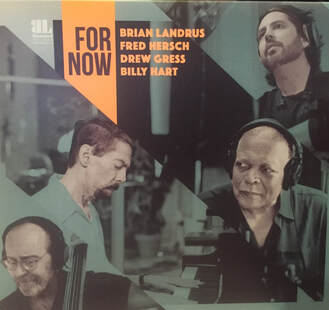
After his acclaimed 2017 large-ensemble album Generations, multi-reedist and composer Brian Landrus becomes more introspective on his 2020 release, For Now. He brings together an excellent quartet in the persons of pianist Fred Hersch, bassist Drew Gress, and drummer Billy Hart. Adding their talents to the quartet are Michael Rodriguez on trumpet and Sarah Caswell on violin along with a string quartet featuring Caswell, Joyce Hamman on violin, Lois Martin on viola, and Jody Redhage-Ferber on cello. An All-Star cast.
The album opens with The Signs, a Brian Landrus original. Michael Rodriguez on trump it makes his first appearance Here and introduces himself with aplomb. The inimitable Fred Hersch shows why Landrus picked him for the piano duty. Then Landrus joins on the baritone saxophone and the whole thing takes on a cool swing. Drew gress and Billy hart’s bass and drums keep a tidy rhythm throughout at all. This is a good way to start an album.
Clarity in Tme is another Landrus original. The string arrangements behind Landrus’ baritone create a longing reminiscence. Everybody knows pianist Fred Hersch, and he proves over and over again that he deserves every moment of recognition that he gets.
Landrus’ The Miss is introduced by Hersch’s solo piano. Hersch weaves in and out of the composition and Landrus takes on the higher tones of the baritone sax. The string quartet adds a fine depth to the melancholy waltz. It is a very introspective piece that invites unbidden memories during the listening. A moving work of art. That melancholy becomes straight up sadness in JJ. Billy Hart’s drums take on a melodic strain on their own and the Gress bass is a fitting partner in rhythm. You have to love the bari sax runs employed by Landrus on the piece which are supplanted by the graceful tones of Rodriquez’ trumpet. Still, keep your ears open for what Hart is doing. Hersch earns his payday in his intelligent piano solo.
For Now, the title track, is introduced by the lush and lyrical string quartet. The warm sounds of Landrus’ bass clarinet climb on top of the strings and Hersch’s piano fills the space in this imaginative and evocative reverie. Then we cut to the standards. Landrus’ bass clarinet takes on the whole of Thelonious Monk’s “Round Midnight. Somewhere, Monk is grinning. The bass clarinet seems like that must have been what Monk had in mind as an alternative to the piano. Landrus definitely has the ear for alternative voicings and interpretations. This in itself was worth the price of admission.
Kaper and Webster’s Invitation is an up-tempo bouncing piece with Landrus back at the bari sax and Hersch and the rhythm section make this swing in all the right ways. Pay attention to Gress’ bass lines here. He and Hart are in lock-step and the support to Hersch is remarkable.
For Whom I Imagined, another Landrus original, is introduced by Caswell’s violin and the string quartet. Landrus’ bass clarinet is like Dante finding himself in a dark wood, wandering, with thoughts of his beloved Beatrice pulling him forward. The alto flute is like the elusive dream who cannot be realized. Wondrously structured and performed.
The Night of Change (Brian Landrus, composer) is a shift in tempo and light-hearted delivery with the alto flute taking the lead. Add in Rodriquez. Trumpet for the fun. A sweet and lovely piece. The Second Time--also a Landrus composition—takes a more dulcet approach with the baritone as the featured instrument. Accented strings cast bright spots against the warmer tones of the sax.
Her Smile and The Wait are also Landrus originals. Rodriquez’ horn and the strings contribute fine textures and tones in Her Smile. Landrus’ baritone and Caswell’s violin are in great dialogue. Gress’ bass is worthy of close attention. It is a light and romantic piece that makes Her Smile my smile. Then they pick up the tempo just a bit with The Wait. Hersch’s piano gets an early solo before the bass clarinet takes centerstage. Waiting for the arrival of the lover, waiting for the phone call, the letter, isn’t doing nothing. It is waiting and so much happens during the wait. The song The Wait is no different; it is full of moments of anticipation from the piano or the bass while Hart keeps up the pitter-patter of the anxious heartbeat. This was fun stuff.
The album closes with Thelonious Monk’s Ruby, My Dear, as if the object of affection all along was Monk’s Ruby. Fred Hersch takes the opening of this classic piano work and then Brain Landrus’ baritone sax takes over the melody, that unmistakable melody. Before long, you realize that it is just Landrus and Hersch, piano and sax, carrying the whole piece. Wonderful interplay.
Through all of For Now, Brian Landrus creates atmospheres of love and longing, wanting and waiting, with a collection of celebrated and accomplished artists who feel it just as deeply as he does.
~Travis Rogers, Jr. is The Jazz Owl
 RSS Feed
RSS Feed
